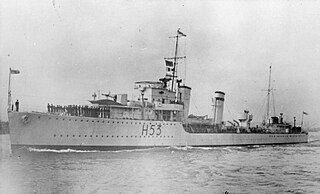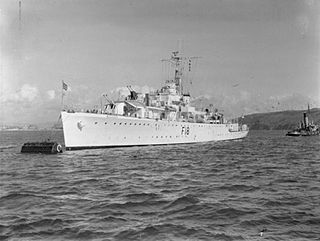
HMS Egret was a sloop of the British Royal Navy, the lead ship of her class. She was built by J. Samuel White at Cowes, Isle of Wight, was launched on 31 May 1938, and entered service on 11 November that year. Egret served as a convoy escort with the Western Approaches Command from 1940 until her loss in August 1943: She was on anti-submarine patrol in the Bay of Biscay when she was sunk by a guided missile in combat, the first ship to be lost in this manner.

HMS Kingston was a K-class destroyer built for the Royal Navy during the 1930s.

HMS Jaguar was a J-class destroyer of the Royal Navy. Commissioned in September 1939, she was present at the Dunkirk evacuation the following year, during which Jaguar was damaged by dive bombers. She later served in the Mediterranean and was involved in several actions there. She was torpedoed off the coast of Egypt on 26 March 1942 and sunk.

HMS Havock was an H-class destroyer built for the British Royal Navy in the mid-1930s. During the Spanish Civil War of 1936–1939, the ship enforced the arms blockade imposed by Britain and France on both sides as part of the Mediterranean Fleet. During the first few months of the Second World War, Havock searched for German commerce raiders in the Atlantic Ocean and participated in the First Battle of Narvik during the Norwegian Campaign of April–June 1940 before she was transferred back to the Mediterranean Fleet in May where she escorted a number of convoys to Malta. The ship took part in the Battle of Cape Spada in July 1940, the Battle of Cape Matapan in March 1941 and the evacuation of Greece in April 1941. She was damaged during the Battle of Crete the following month, but participated in the Syria–Lebanon Campaign in June.

HMS Scarborough was a Hastings-class sloop of the Royal Navy launched in 1930. She served in the Second World War, especially as a convoy escort in the North Atlantic.

HMAS Parramatta (U44) was a Grimsby-class sloop of the Royal Australian Navy (RAN). Built during the late 1930s, Parramatta operated in the Red Sea and Mediterranean during World War II. The sloop was torpedoed by the German submarine U-559 on 27 November 1941, and sank with 138 of the 162 aboard.

HMS Aberdeen was a Grimsby-class sloop in the British Royal Navy. Built in Devonport Dockyard, Plymouth, UK by Thornycroft, she was launched on 22 January 1936.

The Shoreham-class sloops were a class of eight warships of the Royal Navy built in the early 1930s.

HMS Beaufort was a Hunt-class destroyer of the Royal Navy. She was laid down on 17 July 1940 at Cammell Laird, Birkenhead. She was launched on 9 June 1941 and commissioned on 3 November 1941. During the Second World War the ship served in the Mediterranean Sea, escorting convoys and covering landings. She was transferred to the Royal Norwegian Navy in 1952 and scrapped in 1965.

HMS Defender was a D-class destroyer built for the Royal Navy in the early 1930s. The ship was initially assigned to the Mediterranean Fleet before she was transferred to the China Station in early 1935. She was temporarily deployed in the Red Sea during late 1935 during the Abyssinia Crisis, before returning to her assigned station where she remained until mid-1939. Defender was transferred back to the Mediterranean Fleet just before World War II began in September 1939. She briefly was assigned to West Africa for convoy escort duties in 1940 before returning to the Mediterranean. The ship took part in the Battles of Calabria, Cape Spartivento, and Cape Matapan over the next year without damage. Defender assisted in the evacuations from Greece and Crete in April–May 1941, before she began running supply missions to Tobruk, Libya in June. The ship was badly damaged by a German bomber on one of those missions and had to be scuttled by her consort on 11 July 1941.

HMS Dainty was a D-class destroyer built for the Royal Navy in the early 1930s. The ship was initially assigned to the Mediterranean Fleet before she was transferred to the China Station in early 1935. She was temporarily deployed in the Red Sea during late 1935 during the Abyssinia Crisis, before returning to her assigned station where she remained until mid-1939. Dainty was transferred back to the Mediterranean Fleet just before World War II began in September 1939. She briefly was assigned to West Africa for convoy escort duties in 1940 before returning to the Mediterranean. The ship participated in the Battle of Calabria in July 1940 and was assigned to convoy escort and patrol duties until she was sunk by German bombers off Tobruk on 24 February 1941.

HMS Fowey was a Shoreham-class sloop of the Royal Navy. She served during the Second World War.

HMS Leith was a Grimsby-class sloop of the Royal Navy that served in the Second World War.

The Egret-class sloops were a three ship class of a long-range escort vessels used in the Second World War by the Royal Navy. They were an enlarged version of the Bittern class with an extra twin 4-inch gun mounting. They were fitted with Denny Brown stabilisers and the Fuze Keeping Clock anti-aircraft fire control system.

HMS Avon Vale(pennant number L06) was an escort destroyer of the Hunt Type II class. The Royal Navy ordered Avon Vale's construction three days after the outbreak of the Second World War. John Brown Shipbuilding & Engineering Company Ltd laid down her keel at their Clydebank yard on 12 February 1940, as Admiralty Job Number J1569. After a successful Warship Week national savings campaign in February 1942, Avon Vale was adopted by the civil community of Trowbridge, Wiltshire.

HMS Bideford was a Royal Navy Shoreham-class sloop. She was named after the town of Bideford in Devon and was launched on 1 April 1931.

HMS Stork (L81) was a Bittern-class sloop of the Royal Navy. She was active during the Second World War, serving in convoy escort groups, and was a successful anti-submarine warfare vessel, being credited with the destruction of four U-boats.

HMS Grimsby was a sloop of the British Royal Navy, the lead ship of her class. Grimsby was built in the 1930s, entering service in 1934. Serving most of her pre-war service at Hong Kong, Grimsby was deployed on convoy escort duties along the East coast of the Britain and in the Mediterranean Sea during the Second World War, and was sunk by dive bombers off Tobruk on 25 May 1941.

HMS Flamingo was a Black Swan-class sloop of the Royal Navy. She saw service as a convoy escort during the Second World War, seeing extensive service in the Mediterranean and Far East in 1945.

HMS Enchantress (L56) was a Bittern-class sloop, built for the British Royal Navy. She was the lead ship of her class, being laid down as Bittern, but renamed as Enchantress before being launched by Lady Jean Alice Elaine Cochrane. She was active during the Second World War, serving mainly as a convoy escort, and was a successful anti-submarine warfare vessel, being credited with the destruction of an Italian submarine in 1942.



















